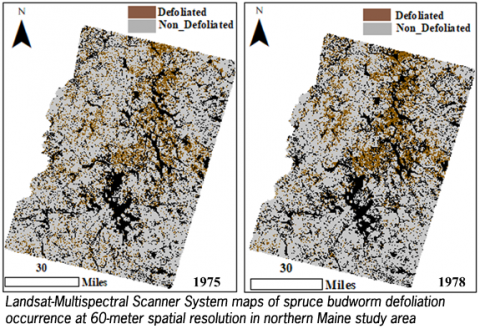Understanding Landscape Level Factors Influencing Spruce Budworm (SBW) Outbreak Patterns in Maine and Forecasting Future Risk

Spruce budworm (SBW) is the most damaging forest pest in northeastern forests. In the 1970s, the last outbreak affected 57 million hectares of spruce-fir. A more current 2006 SBW outbreak in Quebec, Canada caused defoliation of over 13 million hectares by 2020. The outbreak is expected to affect Maine in the near future, with about 2.3 million hectares of spruce-fir stands at risk of defoliation. Forest managers lack a model to forecast the spread of budworm populations across the landscape.
NSRC researchers developed a model to evaluate and predict spatial and temporal dynamics of a spruce budworm outbreak across the complex forested landscape of northern Maine, using historical defoliation data covering approximately 50,000 km2 and 10 years of the last SBW outbreak during the 1970s -1980s in the region. Researchers evaluated historical data sets including annual SBW egg mass surveys, aerial sketch maps, defoliation data collected in the field, historical forest cover type data, and Landsat imagery. The model showed that host tree percentage and velocity of wind have noticeably greater effects than other factors on the spread and intensification of SBW defoliation across the landscape in simulated outbreaks.
The quantitative information generated by the model is usable in forest growth and yield modeling frameworks and management decision support systems, which are useful tools for assessing health, productivity, and succession of forests influenced by SBW defoliation. The analysis is readily extendable to evaluating spatial and temporal dynamics of other forms of defoliation across forest landscapes.
